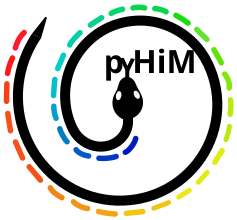mask_2d and localize_2d#
Segments DAPI and sources in 2D
Invoke#
Inside the folder with your input data, run:
pyhim -C mask_2d,localize_2d
Inputs#
Name shape |
Quantity |
Mandatory |
Description |
|---|---|---|---|
parameters.json |
1 |
Yes |
Parameter file. |
<image_name>.tif |
2..n |
Yes |
2D images |
Outputs#
Name shape |
Quantity |
Description |
|---|---|---|
segmented_barecode.ecsv |
1 |
If it’s barecode object |
segmented_mask.npy |
2..n |
If it’s mask object |
Relevant options#
Name |
Option |
Description |
|---|---|---|
operation |
2D |
Select 2D mask segmentation |
3D |
Select 3D mask segmentation |
|
background_method |
inhomogeneous |
|
flat |
||
stardist |
||
stardist_network |
Name of the network used for segmentation |
|
stardist_basename |
Folder containing AI models |
|
background_sigma |
Used to remove inhomogeneous background. Default: 3.0 |
|
threshold_over_std |
Threshold used to detect sources. Default: 1.0 |
|
area_min |
Minimal area to keep object |
|
area_max |
Maximal area to keep object |
|
residual_max |
Maximum difference between axial spot intensity and gaussian fit |
Description#
A 2D mask segmentation produces two outputs saved in the segmentedObjects folder:
scan_002_mask0_002_ROI_converted_decon_ch01_segmentedMasks.png
scan_002_mask0_002_ROI_converted_decon_ch01_Masks.npy
The PNG file is a representation of the raw image and the segmented objects.
The NPY file is a 2D labeled numpy array containing the segmented objects with an identical size to the original image. Background has a value of 0 and each mask contains a different integer. The maximum value in this matrix corresponds to the number of masks detected. The file name is constructed using the original root filename with the tag _Masks.
Warning: This mode operates in 2D, therefore the Startdist network provided must be in 2D.
